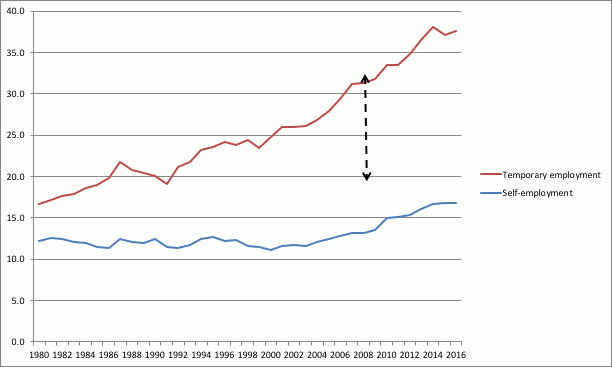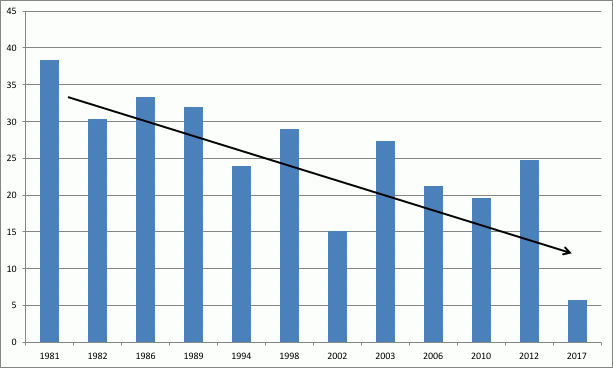Why Are Wages Increasing So Slowly in America?
When labor markets tighten, wages are expected to increase. However, until recently, wage growth was a key missing ingredient in the recovery of the U.S. economy. Nine years into the economic expansion wage growth remained low, even though the rate of U.S. unemployment declined to about 4 percent—the lowest rate of joblessness since the dotcom boom of two decades ago. Only now is U.S. wage growth starting to accelerate—in January the rise in average hourly earnings reached 2.9% on a year to year basis, while inflation during 2017 was 2.1%. With the Republican tax cuts and higher public spending by the Trump administration, observers including Lawrence Summers and Paul Krugman expect high wage growth to persist, and voice fears that inflation will finally pick up.
If this happens, the Fed will conclude that the U.S. economy has become strong enough to deal with further and faster increases in short-term interest rates—with the caveat that the “output gap” is becoming positive mostly because underlying potential output growth is abysmally low. Underlying potential growth of the U.S. economy has been less than 1.25%, writes Jason Furman, which he attributes mostly to an aging population. With historic rates of productivity growth, Furman thinks potential growth would be 2.1% at the most, well below the 3% growth target of the Trump administration. But Furman may be too pessimistic about productivity growth. For the last several years, a lack of demand, low rates of capacity utilization and high rates of un- and underemployment of workers made firms unwilling to invest in new machines, in hardware and software or in new ways of doing things that would raise output per hour of labor. But capital accumulation will pick up again, once wages and demand begin to increase, and then, as is argued in a recent McKinsey Global Institute (2018) report, an acceleration of growth in productivity is a real possibility indeed. The reason is that higher investment brings with it faster embodied technical progress which in turn must raise productivity. Arguing this, McKinsey has reinvented the wheel—because the exact relationship between (investment) demand growth and productivity growth is known in the literature as the Kaldor-Verdoorn relationship (see Storm and Naastepad 2012; Storm 2017). The stronger the Kaldor-Verdoorn relationship, the smaller will be the impact of higher wages and higher demand on inflation —which is another reason why it is better for the Fed to err on the side of caution and not start ramping up the interest rate too early.
The moot point in all this, however, is whether the recent acceleration in annual hourly earnings is really signaling (near) full employment and reliably predicting a looming rise in inflation. There are clear contrary signals of considerable slack in the labor market: most new jobs are temporary jobs, often precarious in nature; the number of discouraged workers not actively looking for a job is still high; and wage growth for rank-and-file production and supervisory employees—likely including proportionately many Trump voters—was considerably below the national average, showing no sign of accelerating (as yet) and, at 2.4%, running barely ahead of the increase in consumer prices (of 2.1%). In addition, a bigger proportion of production and non-supervisory wages are being paid in the form of bonuses, allowing firms to stay flexible and nimble. “I don’t believe we’ll see a long-term increase in real wage growth,” Ken Abosch, a partner at Aon Hewitt, the human resources consulting firm, said in the New York Times (February 10, 2018). The reasons for sluggish wage growth for the majority of U.S. employees are debated and argued to include declining unionization, the increasingly dual nature of U.S. employment, reluctant minimum-wage increases, globalization (greater import competition), and the slowdown of productivity growth (Storm 2017). But the problem is not just American.
European Workers Need a Pay Raise as Well
The lack of association between tighter labor markets and wage growth is not just visible in the U.S. economy. It is a global phenomenon and there are lessons to be learned by the U.S. from the experiences of other nations. Consider the Eurozone where lower unemployment rates are also not leading to higher wage growth (Schulten and Luebker 2017; Buti and Turrini 2017). Bloomberg has called it the “mystery of missing wage growth;” the Financial Times writes about the “Eurozone’s strange low-wage employment boom” (Jones 2017), and the European Commission (2017, p. 24) has put forward the diagnosis of a “wage-poor recovery” in which private consumption remains depressed by stagnant wages. In a remarkable statement coming from the European Central Bank, Mario Draghi (2016) made “an indisputable case for the benefits of having higher wage growth” in the trade-surplus countries of the Eurozone. Draghi further suggested that the official unemployment rate is underestimating the true plight of joblessness: broader measures of “slack” in the labor market which include ‘discouraged workers,” “underemployed part-time workers” and “workers marginally attached to the labor force,” point to a hidden reserve army of workers which is roughly two-thirds the size of the official unemployment rate. The European Commission (2017, p. ix) argues that “the outlook for wages has now moved center-stage for the sustainability of the recovery.” However, notwithstanding all this policy talk, actual wage growth stays poor, even in stronger (booming and trade-surplus) economies such as Germany and the Netherlands. Let me zoom in on the Dutch economy which grew by 3.1% in 2017, the strongest growth in more than a decade.
The Dutch Case: A Growing “Disposable” Workforce
Dutch unemployment declined to 4.1% in December 2017, and Eric Wiebes, the conservative Minister of Economic Affairs, stated that the “Dutch economy is in good shape.” This is unfortunately not showing up in Dutch nominal wage growth, which is neither high nor rising, equaling just 1.7% during 2017. Like the ECB, De Nederlandsche Bank (DNB)—the Dutch central bank—is worried by the stagnant wage growth and the consequent decline of the wage share in GDP. In recent years, the DNB has repeatedly called for substantial nominal wage increases for workers in the so-called “sheltered” sector—which includes industries catering to domestic demand and not exposed to international competition (DNB 2016)—to the surprise of Dutch labor unions and the annoyance of employers’ associations.
While its call for higher wages already gives a new meaning to what is commonly referred to as “unconventional monetary policy,” the DNB went further and investigated the causes of the lack of Dutch wage growth. In a remarkable report published in its DNBulletin of February 1st, DNB researchers single out the incidence of temporary employment and alternative working arrangements (mostly in the form of self-employment) as a main driver of low wage growth and a declining wage share (DNB 2018). As is shown in Figure 1, the share of self-employed and temporary workers in total employment in the Netherlands has grown—steadily—from 16.6% in 1980 to 25% in 2000 and further to almost 38% in 2016. The proportion of temporary workers in the Netherlands in 2016 is almost ten percentage points higher than the average for all OECD countries. Self-employed and temporary workers enjoy (far) less legal employment protection than permanent employees. They are also less unionized and/or organized—only 10% of temporary, self-employed Dutch workers are union members, compared to 24% of permanent employees. The lack of job protection and lack of organization are factors weakening their position in the wage bargaining process.
In addition, the DNB argues (2018) that the growing prevalence of self-employed workers has also weakened the wage bargaining power of “insider” permanent workers who have to compete with “more easily dismissible” workers who cost often only 60 percent of the wage cost of a permanent worker. Using data for eight major industries during 1996-2015, and controlling for the wage-impacts of (skill-biased) technological progress and greater import competition (or globalization), DNB finds a statistically significant negative association between the wage share and the incidence of temporary employment; specifically, an increase of 1% in the share of temporary employment is associated with a decline in the wage share of 0.23 percentage points. Temporary employment in the Netherlands has increased by 15.8 percentage points during 1996 and 2015. Hence, DNB concludes that more than half of the decline in the wage share during these years has to be attributed to this fundamental long-term refashioning or “hollowing out” of the labor market during the previous two decades. The outcome is illustrated in Figure 1 (see also DNB 2017).
Figure 1
Self-Employment Plus Temporary Employment in the Netherlands, 1980-2016 (as a percentage of total employment)

Source: OECD Statistics
History Repeats Itself …. First as Tragedy, Then as Farce
It is important to note that labor market deregulation was not just a conservative political project. In the Netherlands, it had the active support of the social-democratic Labour Party, which in its “Third Way” incarnation prioritized “jobs” over wages, social and employment protection and the quality of jobs (Storm and Naastepad 2015). What is striking, perhaps even paradoxical, is that job growth was to be achieved not by means of traditional demand management by the state (for example, fiscal stimulus), or through the creation of public-sector jobs, but through activating labor market programs offering positive and negative (supply-side) incentives pushing (more) people into the labor market, for instance by shortening the duration of unemployment benefits, introducing job search obligations or cutting benefit entitlements (Bonoli and Powell 2004). Doing so involved the (sometimes drastic) deregulation of labor markets, pension and tax reforms, some tightening of access to social security systems, as well as (on average) real wage growth restraint. Dutch Social Democrats pioneered this strategy in Europe and tellingly, the motto of the two consecutive Dutch governments (1994-2002) led by Labour Party Prime Minister Wim Kok was “jobs, jobs, jobs”—a motto Mr. Kok also gave to the report of the Employment Taskforce (2003), which he chaired in 2003 on behalf of the European heads of state.
Prime Minister Kok openly threw off Labour’s ideological feathers (in a public lecture in 1995), accepting the logic of and constraints imposed by financial markets within which “modern” social democracy must operate. The biggest of those constraints is the one Andrew Glyn (2007) called the “Nasty Trade-Off”: the supposedly ineluctable choice between less inequality (at the cost of higher unemployment and lower growth) and higher employment (only achievable at the price of greater inequality). Third Way social democrats across Europe chose the latter—and Kok’s Labour Party led the way. Dutch wage moderation created (temporary and part-time) jobs but did so as a result of a secular slowdown of labor productivity growth, not higher economic growth (Naastepad and Kleinknecht 2004; Naastepad 2006; Storm and Naastepad 2012, 2015). The Dutch “miracle” of low unemployment, praised by the international business press including The Economist and endorsed by economists including Oliver Blanchard (2000), subsequently inspired the German Social Democrat-led government of Gerhard Schröder to implement the so-called Hartz reforms of 2004-06—a set of labor market reforms which put an end to Germany’s social market economy and pushed millions of workers into insecure, flexible, low-waged jobs (Storm and Naastepad 2015; Odendahl 2017). Both the German and Dutch social democrats operated in the—neoclassical—belief that fuller employment is possible only if one reduces the cost of labor and allows for low-wage flexible services jobs—in one blow discarding decades of continental European social democratic thought in favor of the narrow Anglo-Saxon logic of the non-accelerating inflation rate of employment (NAIRU), in which the “Nasty Trade-Off” takes center stage (see Storm and Naastepad 2012). No wonder that when Margaret Thatcher was asked what she regarded as her greatest achievement, she is said to have replied: “New Labour”. And now French President Emmanuel Macron is trying to copy-paste the Hartz reforms in his country in an attempt to break up France’s supposedly “rigid” labor markets. “There is no alternative” or TINA, as Thatcher once said.
Back to the U.S.A.
What the findings of DNB confirm is that decades of labor market deregulation have created what Alan Greenspan (speaking about the U.S. economy) called workers “traumatized” by job insecurity and afraid or simply unable to press for wage increases (Storm and Naastepad 2012; Weil 2014; Storm 2017). Deregulated and increasingly dualistic labor markets filled with precarious part-time work (Temin 2017; Storm 2017), along with restrictive fiscal policies, created the preconditions for the structurally low inflation and low interest rates during the much-hyped “Great Moderation” of the mid 1980’s-mid 2000’s—which as I have argued elsewhere (Storm 2018a, 2018b) directly propelled asset price inflation, the growth of shadow banking and financial fragility. Coming back to wages and recognizing that the bargaining power of flexible workers has, if anything, not improved, it is difficult to see how economic growth and lower unemployment lead to structurally higher wage growth and higher inflation.
The findings by DNB are already remarkable in and of themselves, coming from the monetary authority and not from the labor unions or some left-leaning economist. But these findings have a bearing on monetary policy discussions in the U.S. as well. The tightening of the labor market no longer automatically results in higher nominal wage growth, because the employment relation has fundamentally changed—as a result of labor market deregulation, the fissuring of the workplace (Weil 2014), outsourcing and the financialization of corporations (Lazonick 2017). The fact that a much higher proportion of workers is working in such flexible “alternative work arrangements” must also contribute to the greater “elasticity” of the labor force itself. In the U.S., millions of discouraged workers who, because of weak job opportunities or due to the opioid crisis, gave up searching for a job, dropped out of the statistics and are not reflected in the official unemployment rate. The number of “missing workers” reached a peak of 3.9 million people in September 2015 according to the Economic Policy Institute, and even now more than one million workers are no longer recorded.
But it is crucial to recognize that the flexibilization of the employment relationship is not recent and not just confined to the growth of the “gig economy” and Uber jobs. This is what the DNB study brings out. It has been a steady and persistent process which started in the 1980s and has been going on for two generations, has continued more or less without interruption until now and may accelerate in the (near) future with robotization and AI. In this decades-long process of structural transformation, millions of workers have been pushed out of permanent employment into often non-standard, precarious forms of self-employment in service sector jobs in technologically stagnant activities (as explained further in Storm 2017). Recognizing what was happening, Paul Samuelson (1998) told a conference sponsored by the Federal Reserve Bank of Boston that “America’s labor force surprised us with a new flexibility and a new tolerance for accepting mediocre jobs.” Anthropologist David Graeber (2013) has called these jobs “bullshit jobs,” writing that “[h]uge swaths of people [….] spend their entire working lives performing tasks they secretly believe do not really need to be performed. The moral and spiritual damage that comes from that situation is profound. It is a scar across our collective soul.”
This brings me to my final point. The most important ramifications of the ongoing flexibilization of work and the fissuring of the workplace are not just stagnant wage growth and rising (wage) inequality, but also job and income insecurity and greater social and individual anxieties arising out of “the grinding reality of continuing, unyielding low pay over many years” (Ferguson, Jorgenson and Chen 2018, p. 28). In the recent U.S. Presidential elections, the “many pressures that had been squeezing voters increased to a point where, quite literally, daily existence for many had become close to unlivable” and “the reality of the Hunger Games was just too obvious” (ibid.). This led enraged voters to express their discontent with the establishment and its mainstream economics policies by voting for two political outsiders, Senator Bernie Sanders and Donald Trump. In other words, macroeconomic mismanagement has huge political costs, and ignoring the political fallout of workers traumatized by decades of labor market deregulation comes at our own peril. The Democratic Party, when it decides to ignore the lessons of the successful Sanders campaign, should contemplate the fate of its “Third Way” companions in Europe. As can be seen from Figure 2, voter support for the Dutch Labour Party has gradually but steady imploded from 1981 to 2017—from earning one-third or more of the voter share in the 1980s to a measly 5.7% share of voter in 2017. Similar catastrophic declines can be observed for the Socialist Party in France, and can perhaps be predicted for the German Social Democrats. The tragedy is that Figure 2 exposes a case of self-destruction. The U.S. Democrats should learn from these experiences—and quickly so.
Figure 2
Percentage of votes for the Labor Party: The Netherlands, 1981-2017

References
Blanchard, O. 2000. ‘The Dutch jobs miracle.’ Project Syndicate. Available at: https://www.project-syndicate.org/commentary/the-dutch-jobs-miracle?barrier=accessreg
Bloomberg. 2017. ‘Draghi is right to hold out for wage growth.’ https://www.bloomberg.com/view/articles/2017-06-09/draghi-is-right-to-hold-out-for-wage-growth , June 9.
Bonoli, G. 2004. Social Democratic party policies in Europe: towards a Third Way? Chapter 11 (pp. 197-213) in G. Bonoli and M. Powell (eds). Social Democratic Party Policies in Contemporary Europe. London: Routledge.
Buti, M. and A. Turrini. 2017. ‘Overcoming Eurozone wage inertia.’ VoxEU.org. 6 October. Available at: https://voxeu.org/article/overcoming-eurozone-wage-inertia
DNB. 2016. ‘Arbeidsinkomensruimte vooral in op het binnenland georiënteerde bedrijfstakken.’ (‘Room for wage increases exists in sheltered industries.’) DNBulletin, November 21, Amsterdam: De Nederlandsche Bank. https://www.dnb.nl/nieuws/nieuwsoverzicht-en-archief/dnbulletin-2016/dnb348373.jsp
DNB. 2017. ‘De flexibilisering van de arbeidsmarkt onder loep.’ (‘Focus on the flexibilization of the labor market.’) DNBulletin, May 11, Amsterdam: De Nederlandsche Bank. https://www.dnb.nl/nieuws/nieuwsoverzicht-en-archief/dnbulletin-2017/dnb358969.jsp
DNB. 2018. ‘Flexibilisering van de arbeidsmarkt gaat gepaard met daling arbeidsinkomensquote.’ (‘Flexibilization of the labor market leads to decline in the wage share’) DNBulletin, February 1, Amsterdam: De Nederlandsche Bank.
Draghi, M. 2016. ‘Introductory statement to the press conference (with Q & A).’ September 8. Available at: https://www.ecb.europa.eu/press/pressconf/2016/html/is160908.en.html
Economic Policy Institute. 2017. ‘Missing workers. The missing part of the unemployment story.’ Available at: https://www.epi.org/publication/missing-workers/
Employment Taskforce. 2003. ‘Jobs, Jobs, Jobs. Creating More Employment in Europe.’ Available at: http://www.ciett.org/fileadmin/templates/eurociett/docs/Kok_Report _2003 _Jobs_Jobs_Jobs.pdf
European Commission. 2017. European Economic Forecast: Spring 2017. Brussels: European Commission, Directorate-General for Economic and Financial Affairs.
Ferguson, T., P. Jorgenson, and J. Chen. 2018. ‘Industrial Structure and Party Competition in an Age of Hunger Games: Donald Trump and the 2016 Presidential Election.’ INET Working Paper No. 66. http://www.ineteconomics.org/uploads/papers/Ferg-Jorg-Chen-INET-Working-Paper-Industrial-Structure-and-Party-Competition-in-an-Age-of-Hunger-Games-8-Jan-2018.pdf
Glyn, Andrew. 2007. Capitalism Unleashed. Finance, Globalization and Welfare. Oxford University Press.
Graeber, D. 2013. “On the phenomenon of bullshit jobs.” Strike Magazine. http://strikemag.org/bullshit-jobs/
Jones, C. 2017. ‘Europe’s strange low-wage employment boom.’ The Financial Times, July 5. Available at: https://www.ft.com/content/63b19fd8-5b1f-11e7-9bc8-8055f264aa8b
Lazonick, W. 2017. ‘Innovative enterprise and sustainable prosperity.’ INET Conference Paper. Available at: https://www.ineteconomics.org/research/research-papers/innovative-enterprise-and-sustainable-prosperity
Naastepad, C.W.M. 2006. ‘Technology, demand and distribution: a cumulative growth model with an application to the Dutch productivity growth slowdown.’ Cambridge Journal of Economics 30 (3): 403-434.
Naastepad, C.W.M. and A. Kleinknecht. 2004.‘The Dutch productivity slowdown: The culprit at last?’ Structural Change and Economic Dynamics 15 (1): 137-163.
Odendahl, C. 2017. ‘The Hartz Myth: a closer look at Germany’s labor market reforms.’ Centre for European Reform.http://www.cer.eu/publications/archive/policy-brief/2017/hartz-myth-closer-look-germanys-labor-market-reforms
Samuelson, P.A. 1998. “Summing up on business cycles: opening address.” in J.C. Fuhrer and S. Schuh (eds.) Beyond Shocks: What Causes Business Cycles. Boston: Federal Reserve Bank of Boston.
Schulten, T. and M. Luebker. 2017. ‘Why won’t wages in Europe rise as they should?’ Social Europe. Available at: https://www.socialeurope.eu/wont-wages-europe-rise
Storm, S. 2017. ‘The new normal: demand, secular stagnation and the vanishing middle class.’ International Journal of Political Economy 46 (4): 169-210. http://www.tandfonline.com/doi/abs/10.1080/08911916.2017.1407742
Storm, S. 2018a. ‘Financialization and economic development: a debate on the social efficiency of modern finance.’ Development and Change 49 (2). Available early on-line: http://onlinelibrary.wiley.com/doi/10.1111/dech.12385/full
Storm, S. 2018b. ‘Financial markets have taken over the economy. To prevent another crisis, they must be brought to heel.” INET blog. Available at: https://www.ineteconomics.org/perspectives/blog/financial-markets-have-taken-over-the-economy-to-stop-the-next-crisis-they-must-be-brought-to-heel
Storm, S. and C.W.M. Naastepad. 2012. Macroeconomics beyond the NAIRU. Cambridge, Mass.: Harvard University Press.
Storm, S. and C.W.M. Naastepad. 2015. “Crisis and Recovery in the German economy: The Real Lessons.” Structural Change and Economic Dynamics, volume 32 (1), pp. 11-24.
Storm, S. and C.W.M. Naastepad. 2016. “Bhaduri-Marglin meet Kaldor-Marx: wages, productivity and investment”, Review of Keynesian Economics, volume 5 (2), pp. 4-24.
Temin, P. 2017. The Vanishing Middle Class. Prejudice and Power in a Dual Economy. Cambridge, Mass.: The MIT Press.
Weil, D. 2014. The Fissured Workplace: Why Work Became So Bad for So Many and What Can Be Done to Improve It. Cambridge, Mass.: Harvard University Press.






